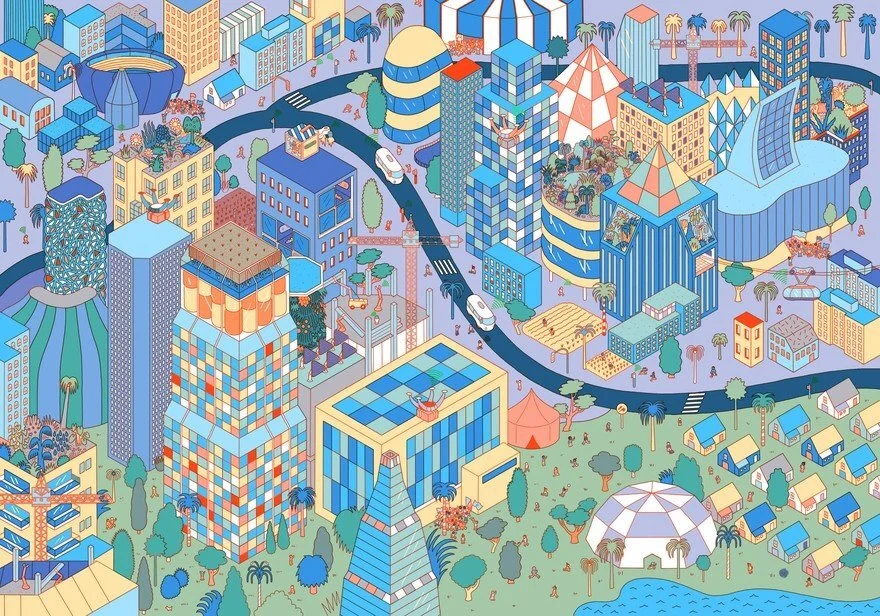Strategic Foresight at Autodesk
Image credit: YimeIsGreat. Taken from “Winter 2030: A Metropolis is Transit",” part of a project by Autodesk’s foresight team
Autodesk can see the future.
That’s an exaggeration, of course. But they’re doing some impressive things to think through the possibilities, and shape them.
Earlier this year I was introduced to Hilmar Koch by a LinkedIn connection of mine. She had spent the summer working with him at the software company Autodesk in their strategic foresight team. Hilmar and I have had a couple of great conversations about why the company stood this team up, how they do their work, and the impact of strategic foresight. There’s a lot there to admire, and for other organizations to emulate.
A big driver for Autodesk in doing foresight, naturally, is the desire to create “a preferable future” for the company. But the perspective on what that is and how to do it a very expansive, outside-in one that’s an embodiment of strategic foresight itself. They’re not just looking at the future of the software industry itself, to stake out an advantageous position enabled by insights their competitors lack. They’re not just thinking about how the industries they serve (architecture, engineering, and construction; product design and manufacturing; media and entertainment) are changing and converging.
The focus is also on those industries’ customers. And who are they? Well, we all live in built environments of some kind. We all use manufactured products. We all rely on a dizzying, and growing, number and type of digital media experiences every day. The customers of Autodesk’s customers are practically everyone on the planet. How they live and how they work are changing in profound ways. It takes efforts like the company’s “Future of Work Initiative” and the foresight team’s “Forces of Change” project to take that into account. Hilmar described the latter project to me as “a systems view of the world, identifying the drivers that will have the biggest impact on the ecosystem” and what those impacts could be.
Ecosystem meaning, of course, not just the natural environment, but also how built and manufactured and digital experience environments could interact with natural landscapes. And most importantly, the range of effects those environments could have on people. I listened recently to a webcast interview with Radha Mistry, the foresight practice lead at Autodesk. She described the ambition of the team and the project this way: “we’re thinking through – who do these futures impact? Who are they preferable for? How do we design and make successfully for human beings” in the future?
I was struck how often I heard Hilmar and Radha talk about preferable futures in the context of their customers and their customers’ customers. Backcasting from that expansive view illuminates an expansive number of product development and other opportunities for Autodesk. That’s what thoughtfully conceived and well executed strategic foresight can do for a company. It also reflects what clearly is a sincere corporate objective for Autodesk products to be pivotal in designing and making a better world.
Another thing that stood out to me as I’ve learned about Autodesk’s foresight work is the composition of the team. There are three pillar areas within the foresight practice. One is Thought Leadership, charged with nurturing a network of external experts and company employees to contribute points of view on a wide range of topics. This feeds the Foresight Methods group, who look systematically with the techniques and tools of the field at weak signals and forces of change. They also facilitate discussions throughout the company on what these could mean for Autodesk’s future directions. Most interesting to me is the Storytelling group, skilled in how to shape what comes out of the foresight activities into narratives that inspire Autodesk leaders, employees, and customers to move in new directions.
In a small team with the kind of mission they have, this isn’t an organizational wiring diagram, of course. The members of the different practice areas naturally work in concert with one another. But the recognition of these three complementary functions is a smart design choice for compounding the effects that each of the functions can have. It taps into the creativity of the whole company (and many others) and flows the synthesis of that creativity back out as a shared vision (visions, really). It demonstrates to the customer base that Autodesk is listening to them, and to many others, while leading them at the same time.
As Hilmar pointed out to me, it’s also a team that “integrates essential practices into long-range strategic foresight” – leveraging diverse ideas, rigorous analysis of the alternative stories those ideas can create, and an ability to persuade decision makers to move forward with actions that can make preferable stories come true. Being an essential partner to the corporate strategy process, reflecting this foresight mindset, may be the Autodesk team’s greatest value. And that’s something leaders in other organizations can adopt and emulate even without a dedicated foresight team.

